Our Blog - Roquefort, France blog
Roquefort is a sheep milk cheese from the south of France, and together with Bleu d'Auvergne, Stilton, and Gorgonzola is one of the world's best known blue cheeses. Growing up, I remember getting Roquefort (blue cheese) dressing for salads, although I can't seem to find it for sale really anymore (I remember it being Kraft, and Kraft has blue cheese dressing, but not Roquefort dressing). I don't remember ever having the actual cheese itself as a kid, however. But regardless, I didn't actually know what "Roquefort" was or meant at that time. Now that I am in France, I found out a bit more about Roquefort ... Though similar blue cheeses are produced elsewhere, EU law dictates that to be called "Roquefort", the cheese MUST be aged in the natural Combalou caves of Roquefort-sur-Soulzon, as it is a recognized geographical indication, or has a protected designation of origin.
Lucky for us, the Combalou caves of Roquefort-sur-Soulzon are between 2 and 2 1/2 hours by car from Toulouse. So on a chilly (but sunny) Saturday, we headed that direction. The drive itself is quite interesting, as once you get nearby, you are driving around these massive valleys, up and down, winding with hairpin curves. The town itself seems to be built almost into the side of the a cliff. Above it hangs the Combalou plateau, which was supposedly created by landslides triggered by an earthquake long ago. The Massif Central, which covers about 15% of France, has mountains, valleys, and plateaus that were created in the late Paleozoic era when two of the earths tectonic plates collided. In the southern part of the Massif Central, there are large plateaus like the Combalou plateau, which have natural caves.

The town of Roquefort-sur-Soulzon is pretty much a "cheese town" with almost all of the activity in the town related to the production of Roquefort cheese. It is also a pretty small town. Probably due to a change in manufacturing techniques (and automation), the population of the town has dropped dramatically ... from nearly 1500 in the 60's to under 700 in 2008. The Cambalou caves, the specific place where all Roquefort cheese must be aged, is only 2 kilometers (1.2 mi) long and 300 meters (980 ft) wide, so not a huge area. We weren't sure why but the town was pretty dead for a Saturday (at least to us). We were not the only ones on the tour, but it was a pretty small group. But it was a cute little town :-) There are seven Roquefort producers in town, most of them with a store or factory that you can visit, and several have cave tours as well.


As I mentioned, there are 7 cheese producers of Roquefort cheese, and we visited one called Papillon (which means butterfly in French). We had picked up some Papillon Roquefort cheese at the Pink Garlic festival last year, and so knew of the guided visits to the caves from a brochure that we picked up at that time. While there were other guided visits to caves, we decided to stay with the one that we knew.
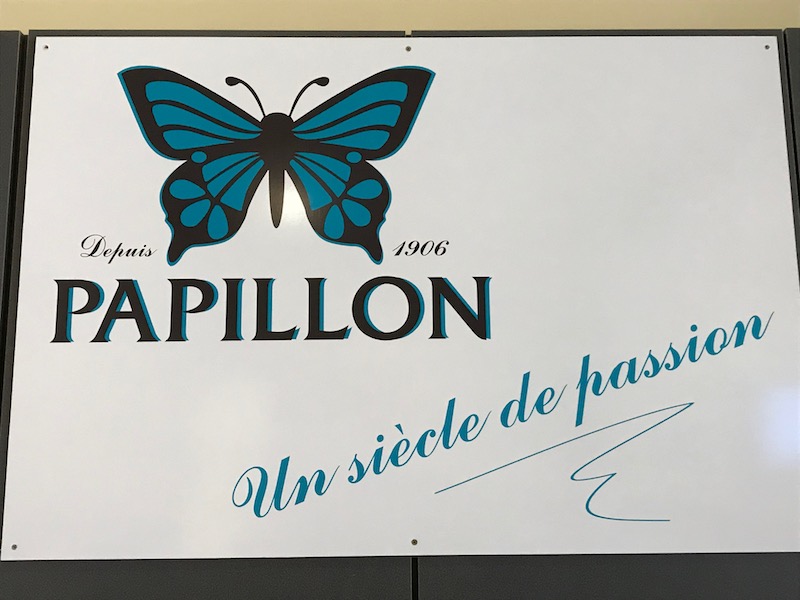
Now the cheese ... Legend has it that the cheese was discovered when a youth, eating his lunch of bread and ewes' milk cheese, saw a beautiful girl in the distance. Abandoning his meal in a nearby cave, he ran to meet her. When he returned a few months later, the mold (Penicillium roqueforti) had transformed his plain cheese into Roquefort. Some say that Roquefort was praised by Pliny the Elder in AD 79, in fact, Pliny simply speaks of a cheese from Gaul, not mentioning its origin or even saying that it was blue. That small detail didn't stop the Société des Caves promoting the story. In 1411, Charles VI granted a monopoly for the ripening of the cheese to the people of Roquefort-sur-Soulzon as they had been doing for centuries.
The cheese is white, tangy, crumbly and slightly moist, with distinctive veins of blue mold. It has characteristic odor and tangy flavor .. and is slightly salty. The cheese is produced in a round wheel shape (called a loaf) that weigh about 3 kilos and take 13 liters of milk to produce. The milk is not just ANY milk ... it is also controlled. The milk used must be unpasteurized (raw) sheeps milk cheese from the Lacaune breed of sheep (not just any sheep) AND the sheep can only be raised (and the milk collected) from a very distinct area which includes the department of Averyron, as well as parts of Aude, Lozère, Gard, Hérault and Tarn. Any other milk and it can't be called Roquefort. Here you can see what a loaf looks like (the round white wheels on the shelves) although these were just for the tour and they were not actually cheese loaves.
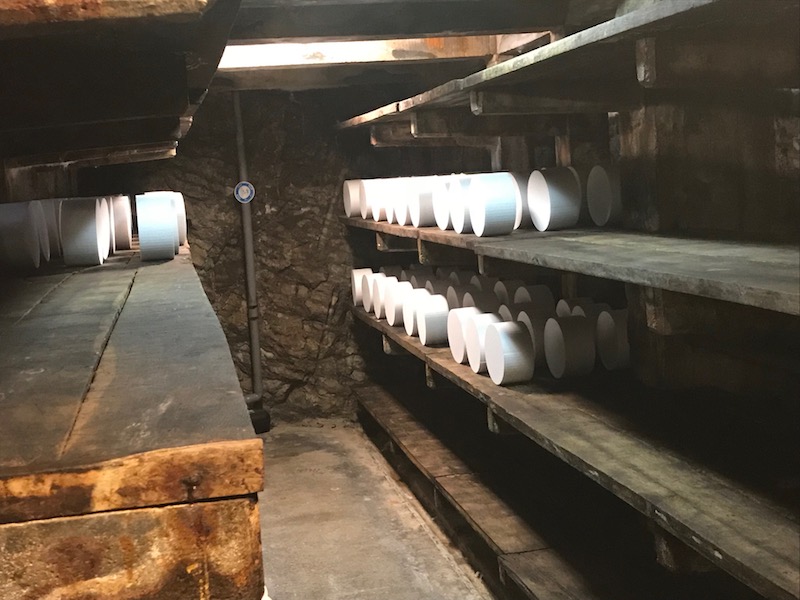
There are several steps in the process and the Papillon tour was nice in that it started with two videos. The first was old archive footage of how the cheese was made back in 1927 and walked us through the various steps (with English subtitles!). There are two main parts to making the cheese ... the cheese itself, and the "mold". We'll start with the mold. The mold that gives Roquefort its distinctive character (Penicillium roqueforti) is found in the soil of the local caves. Traditionally, the cheesemakers extracted it by leaving bread in the caves for six to eight weeks until it was consumed by the mold. The interior of the bread was then dried to produce a powder. Today, some producers may grow the mold in a laboratory, which allows for greater consistency but Papillon still does it the old-fashioned way. In September, they make (locally) about 300 round loaves of rye bread. The bread is cooked in a really hot oven so that the outside is basically charred, but the inside of the loaf is still raw. They then inject mold spores into the interior and sit them on shelves within the caves. The fungus (he actually used the french term for "mushroom" in the presentation, which was a little confusing for us at first) grows on the inside for about 40 days. It then gets opened and dried, then ground into a powder. They separate the mold from the bread and, voila, mold!


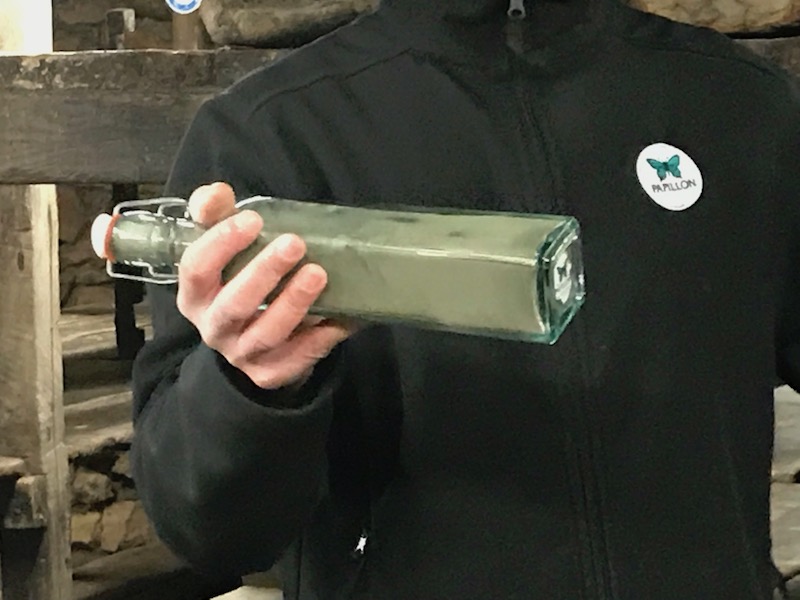
The milk comes in from the local sheep, which is collected twice a day. As with basically all cheese, it goes through a process where rennet is added to coagulate the milk and turn it into curd. Once it is thickened, the now-curdled milk is cut into small cubes and mixed to separate the curds (which becomes the cheese) from the whey. Yes, until now I really didn't understand exactly what the "curds and whey" were that Little Miss Muffet was eating! They take the little cubes of curd and it goes into round metal containers and the powdered Penicillium roqueforti mold is mixed in. It isn't packed too tightly, as the spaces between the curds are actually where the mold will grow. They are turned and drained for between 2 and 7 days and then removed from the metal moulds. A layer of course salt is then put on all of the sides. The salt does a couple things ... salt is a natural preservative, it helps impart the normal salty flavor, and it helps with the development of the Penicillium roqueforti mold. Small holes are bored through from top-to-bottom, which allows for airflow through the cheese and also is for the development of the Penicillium roqueforti mold.
They are then transferred from the dairy to the caves. By "law" (the regulations that dictate what it takes to be called Roquefort), they must stay at least 2 weeks to let the Penicillium roqueforti mold fully develop on the interior although the average at the Papillon cheese caves is 20 days. This is called the ripening stage. During this stage, the cheese masters pull out slivers of the cheese at intervals to check on the progress and determine when to end this stage based on how well the mold has developed on the inside. When it is determined that this "ripening" period is completed, it moves to the maturing stage.
In this stage, it is removed from the caves, the exterior salt is brushed off, and they are wrapped in foil. This slows down the growth of the Penicillium and prevents a crust from developing on the outside. The loaves then go into very cold and very humid rooms to continue the maturation process. They stay here for anywhere between 4-7 months, depending on the cheese.
They have several different Roquefort cheeses with slightly different qualities. All of them come from the same loaves. For example, they have a "premium" which is created from the sections of the loaves which have the most "blue" sections, and these are generally only available from cheese stores. They have a softer taste "red", which is sold in the supermarket. We picked up a piece of their Papillon Taste-Fromage, which is their original kind, and their Papillon Revelation, which was created for the 100th anniversary of Papillon and is for people who are just starting to eat Roquefort .. it is the mildest and has a slightly buttery texture.
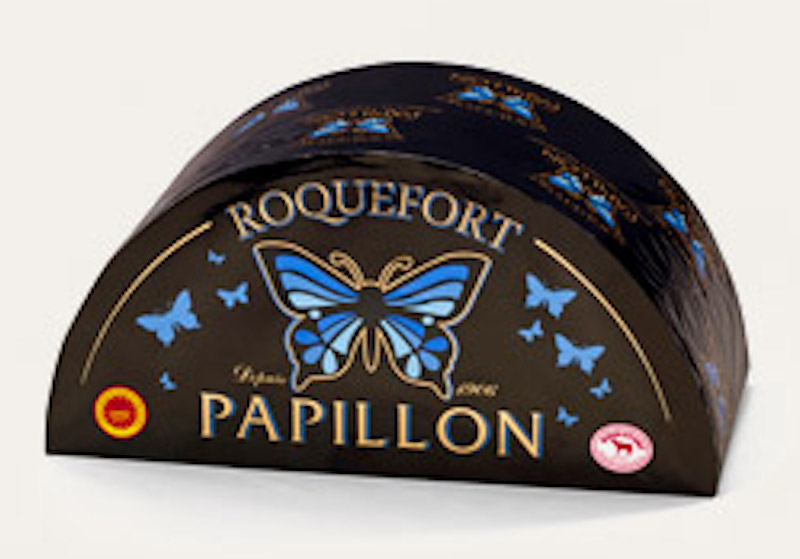
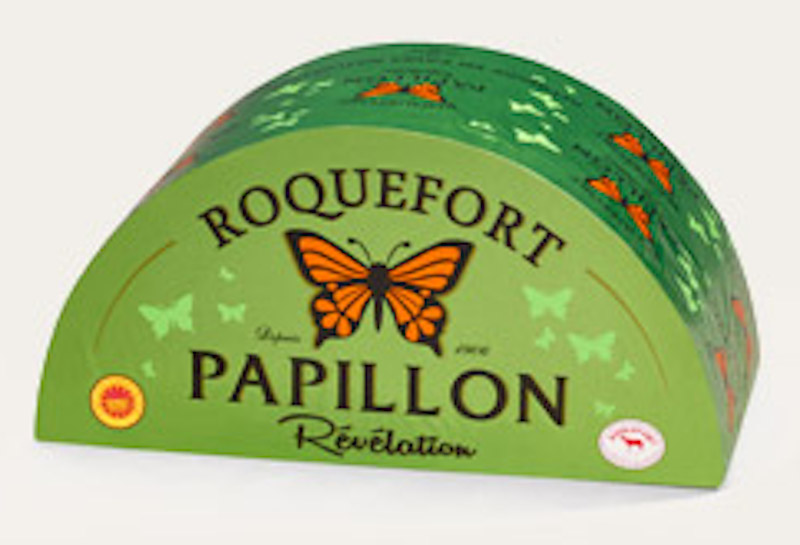
And just for some trivia .... in 2017, Papillon sold 2000 tons of Roquefort cheese, 38% of it went internationally .... According to wikipedia (and the book The Science of Cheese by Tunick Hughes), before Alexander Fleming discovered penicillin, it was common in country districts for shepherds to apply this cheese to wounds to avoid gangrene.